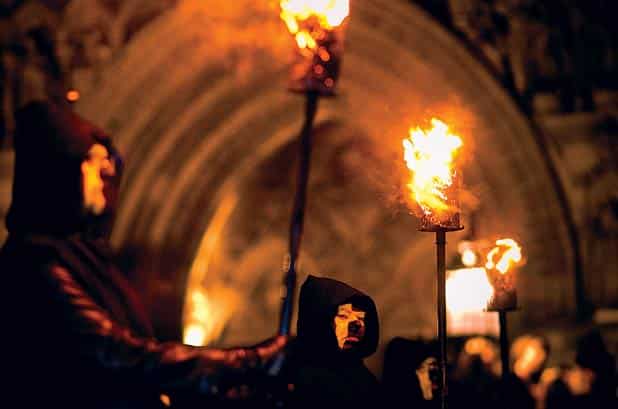For many, October 31 is Halloween, a day and night of wearing costumes and trick-or-treating. Halloween in fact has its roots in the ancient Celtic world. Carving pumpkins (originally turnips), wearing costumes, and conjuring spirits of the departed are just a few of the activities that have origins in Samhain (SAH-win).
A Change of Seasons
Samhain is a Gaelic festival that marks the end of the harvest season and the beginning of the “darker half” of the year. It falls on October 31, beginning at sunset and continuing until sunset on November 1 (All Saint’s Day), approximately halfway between the autumn equinox and the winter solstice. Samhain is one of the four primary Celtic seasonal festivals, the others being Imbolc (February 1), Beltane (May 1) and Lughnasadh (August 1).
Ancient Pagan Origins
There is evidence that Samhain has been an important celebration since ancient times. The Mound of the Hostages, a neolithic passage tomb at the Hill of Tara, is aligned with the Samhain sunrise. Samhain is mentioned in some ancient Irish literature dating back to the 10th century. Many important events in Celtic mythology begin or occur near the time of Samhain.

If Beltane (May 1) marks the livestock being driven to their summer grazing fields, Samhain marks the time that the cattle were brought in from the fields and several slaughtered for the winter. At Beltane and Samhain, bonfires were lit which were believed to have protective and cleansing powers. At Samhain in particular, during the shortening, darker days the bonfire mimicked the sun, fueling growth and holding back the darkness.
The Thin Veil
At Samhain, it is believed that the veil between the physical world and the spiritual (or “other”) world is at its thinnest. This means spirits (the Aos Si, also called fairies) can easily cross between realms and enter our world. The ancient Celts felt the need to please the spirits in order to ensure that their population and livestock did not die during the harsh winter. Food and drink were often left for the fairies, and occasionally an animal was sacrificed to appease the spirits.
Souls of the departed were believed to revisit their homes seeking hospitality. In some cases, a place setting of food or drink was put on the dining table in anticipation of the visit. Mumming, or wearing disguises were part of the festival and involved people going door to door in costume or disguise, reciting verse in exchange for food. Trick-or-treating, anyone?
Samhain Rituals
At household festivals throughout the ancient Celtic world, rituals were believed to tell the fate of the gathered celebrants, particularly as relates to marriage and death. Apples, associated with the spirits and immortality, and hazelnuts, associated with divine wisdom, were often used in the rituals.
One of the most common games was apple bobbing or suspending apples from string and trying to take a bite while blindfolded. Apples were peeled with one long peel being tossed over the shoulder. The shape the peel formed was said to be the first initial of the future spouse’s name. Two hazelnuts were roasted on the fire; one for the person roasting them and one for the person they desired. If the roasting nuts jumped away from each other, it was believed to be a bad match.
Small items were hidden in food, usually a fruit bread called barmbrack. Upon eating, if you found one in your piece of cake, the type of trinket foretold your future. For example, a ring meant marriage and a coin meant wealth.

The costumed celebrants usually carried a form of illumination against the dark night. Usually it was a hollowed out turnip, carved with grotesque faces, with a lit candle inside. Lanterns were also set on windowsills to represent the supernatural beings and to ward off evil spirits.

The tradition of carving pumpkins dates back to the 18th century. An Irishman blacksmith named “Stingy Jack” invited the Devil to drink with him at the tavern. Jack convinced the Devil to turn himself into a coin so Jack could pay for the drinks. Being a cheapskate, Jack pocketed the coin and left the tavern. Thus the Devil could not return to his original form. Jack eventually freed the Devil in return for the promise that the Devil would not claim Jack’s soul when he died. Jack was denied entrance to Heaven, and the Devil also denied him entrance to Hell. The Devil gave Jack a lantern made from a carved turnip and sent him off to wander the land restlessly. The Irish referred to this ghostly figure as Jack of the Lantern, and then simply “Jack-O-Lantern”. In the new world, Irish immigrants found turnips were not plentiful, so began carving the lanterns out of pumpkins.
